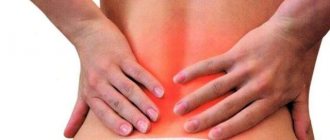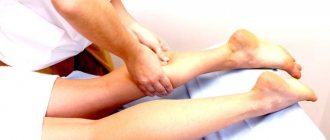Composition and release form
Mydocalm® Film-coated tablets - 1 tablet.
tolperisone (in the form of hydrochloride) - 50 mg - 150 mg excipients: citric acid monohydrate; colloidal silicone anhydrous; stearin; talc; MCC; corn starch; lactose monohydrate; titanium dioxide; macrogol 6000; hydroxypropyl methylcellulose 2910 in blister 10 pcs.; There are 3 blisters in a box. Mydocalm®-Richter Solution for injection - 1 amp. (1 ml) tolperisone (in the form of hydrochloride) - 100 mg lidocaine (in the form of hydrochloride) - 2.5 mg excipients: methylparaben; diethylene glycol monoethyl ether; water for injection in dark glass ampoules of 1 ml; There are 5 ampoules in a box.
Mydocalm - a medicine for back and muscle pain
Pain is not the most pleasant thing the body can give us. Especially if it is strong, and, even worse, permanent. In such cases, the attending physician may prescribe the muscle relaxant Mydocalm, which helps relieve tension and pain.
The doctor prescribes Mydocalm for back and muscle pain
The drug helps relax skeletal muscles as a result of neurological syndromes, which in turn are associated with pain and impaired trophism (the process of cellular nutrition of organs and tissues); reduction of hypertonicity and spasticity; has a local anesthetic effect.
Indications for use
Mydocalm is prescribed in the following cases:
- pathologically increased muscle tone and spasms of skeletal (striated) muscle tissue, which are a consequence of organic lesions of the central nervous system, including multiple sclerosis, encephalomyelitis, cerebral stroke, etc.;
- myogenic contractures, increased muscle tone and spasticity caused by diseases of the musculoskeletal system (for example, lumbago with sciatica, spondylosis, arthrosis affecting large joints, cervical syndrome, etc.);
- non-inflammatory diseases of the brain, accompanied by disorders of muscle tone;
- cholelithiasis;
- severe pain syndrome, observed against the background of the development of hemorrhoids;
- menstrual pain syndrome;
- the threat of spontaneous abortion due to increased tone of the uterine muscle structures;
- renal colic;
- during the period of rehabilitation therapy after orthopedic, surgical or traumatological operations;
- as part of complex therapy for obliterating vascular diseases (arteriosclerosis, diabetic angiopathy, thromboangiitis, Raynaud's disease, diffuse scleroderma);
- pathologies caused by disorders of vascular innervation (acrocyanosis, intermittent angioedema);
- Little's disease (cerebral spastic palsy) and other encephalopathies accompanied by muscular dystonia;
- diseases occurring with muscular dystonia;
- osteochondrosis.
Contraindications
Contraindications to the use of Mydocalm tablets:
- age up to one year;
- persistent pathological weakness and rapid fatigue of skeletal muscle tissue (myasthenia gravis);
- increased individual sensitivity to the active substance and auxiliary components of the drug.
All muscle relaxants are contraindicated in patients:
- currently or with a history of increased seizure activity;
- those suffering from Parkinson's disease;
- suffering from chronic renal and/or liver failure;
- suffering from epileptic seizures;
- having a history of drug addiction;
- with a history of acute psychosis.
Side effects of the drug Mydocalm
Taking the medicine Mydocalm can provoke the appearance of adverse reactions from various organs and systems.
One of the side effects of Mydocalm is insomnia.
Infrequent (occur no more than once in a thousand cases) reactions that may occur after taking Mydocalm include:
- eating and metabolic disorders, which are expressed in the form of anorexia;
- insomnia and sleep disorders;
- headache, dizziness, increased drowsiness;
- arterial hypotension;
- feeling of discomfort in the abdomen, diarrhea, increased dryness of the mucous membrane in the mouth, dyspeptic symptoms, nausea;
- muscle weakness, pain in the limbs, muscle pain;
- asthenia, feeling of general discomfort, increased fatigue.
Rare (occur more than once in a thousand cases, but less than once in ten thousand cases) include:
- anaphylactic reaction;
- decreased activity, depressive states;
- disturbances of attention, tremor, increased convulsive activity, hypoesthesia (decreased sensitivity to the effects of stimuli), paresthesia, increased drowsiness;
- tinnitus, vertigo;
- angina pectoris, tachycardia, rapid heartbeat, decreased blood pressure;
- hyperemia of the skin;
- difficulty breathing, nosebleeds, rapid breathing;
- pain in the epigastric region, constipation, flatulence, vomiting;
- mild forms of liver dysfunction;
- allergic dermatitis, increased sweating, itching, urticaria, skin rashes;
- feeling of discomfort in the limbs;
- enuresis, proteinuria;
- feeling of intoxication, feeling of heat, irritability, increased thirst;
- increased bilirubin levels in the blood, changes in the activity of liver enzymes, decreased platelet levels, leukocytosis.
Extremely rare (occur no more often than in one in ten thousand cases) include:
- anemia, enlarged lymph nodes (lymphadenopathy);
- anaphylaxis (anaphylactic shock);
- polydipsia;
- confusion;
- bradycardia;
- osteopenia;
- feeling of discomfort in the chest;
- increase in creatinine level in the blood.
If the patient experiences side effects, the dose of the drug is reduced, after which the reactions described above are usually leveled out.
How to take Mydocalm?
The dosage and period of taking the drug are calculated by the doctor based on medical history, muscle tone, intensity of pain, the presence of contraindications in the patient and concomitant chronic diseases.
Usually the duration of treatment does not exceed ten days. After administration, Mydocalm begins to act approximately 40 minutes later. The effect lasts from 4 to 6 hours.
Mydocalm is available in two dosage forms:
- tablets 50 mg and 150 mg;
- solution for injection in ampoules of 1 ml.
Mydocalm is taken orally, strictly after meals, with a small amount of water. To avoid complications and side effects, you should strictly follow the dosage prescribed by your doctor.
The average therapeutic dosage of the drug depends on the age of the patient. Doses of the drug (tablets):
- adults and children over 14 years of age: 50 mg 2-3 times a day, gradually increasing the dose to 150 mg;
- children aged 7-14 years: daily dose at the rate of 2-4 mg/kg (in 3 divided doses during the day);
- children aged 3 to 6 years: daily dose at the rate of 5 mg/kg (in 3 divided doses during the day).
Doses of the drug (injections):
- intramuscularly – 200 mg per day, divided into two doses;
- The drug is administered intravenously slowly, by drip, 1 ml once a day.
Mydocalm during pregnancy and lactation
Like any medicine, Mydocalm is prescribed with caution to pregnant women and mothers who are breastfeeding. This occurs only when the expected benefit to the mother outweighs the risks to the fetus or newborn. Experts recommend transferring the baby from breastfeeding to artificial feeding while taking the drug.
Mydocalm during pregnancy
However, Mydocalm can be prescribed to women in the first trimester of pregnancy if there is a threat of miscarriage.
Mydocalm for osteochondrosis
Like other centrally acting muscle relaxants, Mydocalm can be prescribed for osteochondrosis. The pain syndrome, which is inevitable with this disease, entails limited mobility. This is where muscle relaxants, in particular Mydocalm, come to the rescue.
A drug:
- relieve pain symptoms;
- suppresses spinal reflexes;
- relieves muscle tension.
Due to these qualities, muscle relaxants are included in the therapeutic course along with massage, exercise therapy, etc. Moreover, it is worth noting that, unlike chondroprotectors, they actually improve the condition of patients suffering from osteochondrosis.
Mydocalm is prescribed for osteochondrosis
For the treatment of osteochondrosis, Mydocalm, like other muscle relaxants, is prescribed in short courses.
Interaction
Studies have shown that medications that would limit the use of Mydocalm have not been identified. Since the active substance of Mydocalm - tolperisone - does not provoke a sedative effect, it can be combined with drugs that have a sedative effect, as well as sleeping pills and drugs containing alcohol.
The activity of the substance is enhanced by:
- preparations for general anesthesia;
- peripherally acting muscle relaxants;
- psychotropic drugs;
- clonidine (a substance that has a hypotensive effect).
Doctors often prescribe to patients with pathologies of the musculoskeletal system a combination of the drugs Milgamma, Movalis and Mydocalm as a complex therapy.
Thus, Mydocalm and Movalis relieve pain, spasms and muscle hypertonicity. And the drug Milgamma, which belongs to the B vitamins, is used as a general tonic with metabolic, analgesic and neuroprotective effects.
The combination of Mydocalm and alcohol is acceptable. But in any case, you shouldn’t get carried away, since Mydocalm is a medicine.
The regimen for simultaneous use of several drugs is determined by the attending physician.
Analogues of Mydocalm
Often analogues are selected by a doctor if the patient is intolerant of the active substance or components of the drug, due to contraindications or even price.
Analogues of Mydocalm
Analogues of the drug:
- Sirdalud (active ingredient: tizanidine) - Mydocalm has a wider spectrum of action, but Sirdalud is characterized by fewer side effects;
- Miolgin (active ingredients: paracetamol and chlorzoxazone) - indications for use and scheme of action are similar to Mydocalm. Additionally, it has an antipyretic effect;
- Tolperisone-OBL (active ingredient: tolperisone) - the active component, indications, contraindications and scheme of action are identical. Tolperisone is characterized by its low cost;
- Baclofen (active ingredient: baclofen) - the effectiveness of the drugs is similar, but Baclofen has a rather impressive list of side effects.
Analogs have a similar effect on the body, but changing Mydocalm to another, similar medication is possible after consultation and permission from the attending physician.
Sources
- Kamchatnov P.R., Umarova H.Ya., Chugunov A.V., Kazakov A.Yu. // Neuromuscular diseases. — 201 z. -No. 3. — P.32-37.
- Kovalchuk V.V., Skoromets A.A., Vasilyeva I.V. // Journal. neurology and psychiatry named after. S.S. Korsakov. - 2008. - No. 8. — P.14-19.
- Kremis V.M. // Kubansk. scientific honey. messenger -2009. - No. 3 (180). — P.63-66.
- Pretzel HG, Aiken RG, Ramm s. Pain 67.41?, 1996.; 2. Gurak S.V., Parfenov B.A., Borisov K.V. Pain, Daz (12) 2006; 3. Dultn J., Kovacs L., Ramm S. et al. Pharmacopsychlatr., 1998,31,137-142;
- Bakheit AM, Thilmann AF, Ward AB et al. A randomized, double-blind, placebo-controlled, dose-ranging study to compare the efficacy and safety of three doses of botulinum toxin type A (Dysport) with placebo in upper limb spasticity after stroke. Stroke 2000;31:2402—b.
Mydocalm-Richter, 100 mg+2.5 mg/ml, solution for injection, 1 ml, 5 pcs.
Gedeon Richter, Hungary
Price from 446₽
Mydocalm, 50 mg, film-coated tablets, 30 pcs.
Gedeon Richter, Russia
Price from 339₽
There are contraindications. Specialist consultation is required.
Indications for use of Mydocalm
Mydocalm should be taken for spinal and cerebral palsy with increased tone, spasms, spinal automatism, for contractures of the limbs, for diseases with dystonia, rigidity, spasms, obliterating vascular diseases: obliterating atherosclerosis of the vessels of the extremities, diabetic angiopathy, thromboangiitis obliterans, Raynaud's syndrome, consequences of disorders vascular innervation (acrocyanosis, intermittent angioedema), postthrombotic disorders of lymph circulation and venous circulation, trophic ulcer of the leg, spastic paralysis, encephalopathy, a combination of hypertonicity with a violation of muscle tone of another type.









